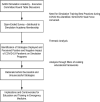Simulation-based emergency medicine education in the era of physical distancing
- PMID: 33786408
- PMCID: PMC7995220
- DOI: 10.1002/aet2.10586
Simulation-based emergency medicine education in the era of physical distancing
Abstract
Background: The COVID-19 pandemic posed significant challenges to traditional simulation education. Because simulation is considered best practice for competency-based education, emergency medicine (EM) residencies adapted and innovated to accommodate to the new pandemic normal. Our objectives were to identify the impact of the pandemic on EM residency simulation training, to identify unique simulation adaptations and innovations implemented during the pandemic, and to analyze successes and failures through existing educational frameworks to offer guidance on the use of simulation in the COVID-19 era.
Methods: The Society for Academic Emergency Medicine (SAEM)'s Simulation Academy formed the SimCOVID task force to examine the impact of COVID-19 on simulation didactics. A mixed-methods approach was employed. A literature search was conducted on the subject and used to develop an exploratory survey that was distributed on the Simulation Academy Listserv. The results were subjected to thematic analysis and examined through existing educational frameworks to better understand successes and failures and then used to generate suggestions on the use of simulation in the COVID-19 era.
Results: Thirty programs responded to the survey. Strategies reported included adaptations to virtual teleconferencing and small-group in situ training with a focus on procedural training and COVID-19 preparedness. Successful continuation or relaunching of simulation programs was predicated on several factors including willingness for curricular pivots through rapid iterative prototyping, embracing teleconferencing software, technical know-how, and organizational and human capacity. In specific instances the use of in situ simulation for COVID-19 preparedness established the view of simulation as a "value add" to the organization.
Conclusions: Whereas simulation educator's responses to the COVID-19 pandemic can be better appreciated through the lens of iterative curricular prototyping, their successes and failures depended on existing expertise in technological, pedagogical, and content knowledge. That knowledge needed to exist and synergize within a system that had the human and organizational capacity to prioritize and invest in strategies to respond to the rapidly evolving crisis in a proactive manner. Going forward, administrators and educators will need to advocate for continued investment in human and organizational capacity to support simulation-based efforts for the evolving clinical and educational landscape.
© 2021 by the Society for Academic Emergency Medicine.
Figures



References
-
- Barry Issenberg S, McGaghie WC, Petrusa ER, Lee Gordon D, Scalese RJ. Features and uses of high‐fidelity medical simulations that lead to effective learning: a BEME systematic review. Med Teach. 2009;27:10‐28. - PubMed
Grants and funding
LinkOut - more resources
Full Text Sources
Other Literature Sources

